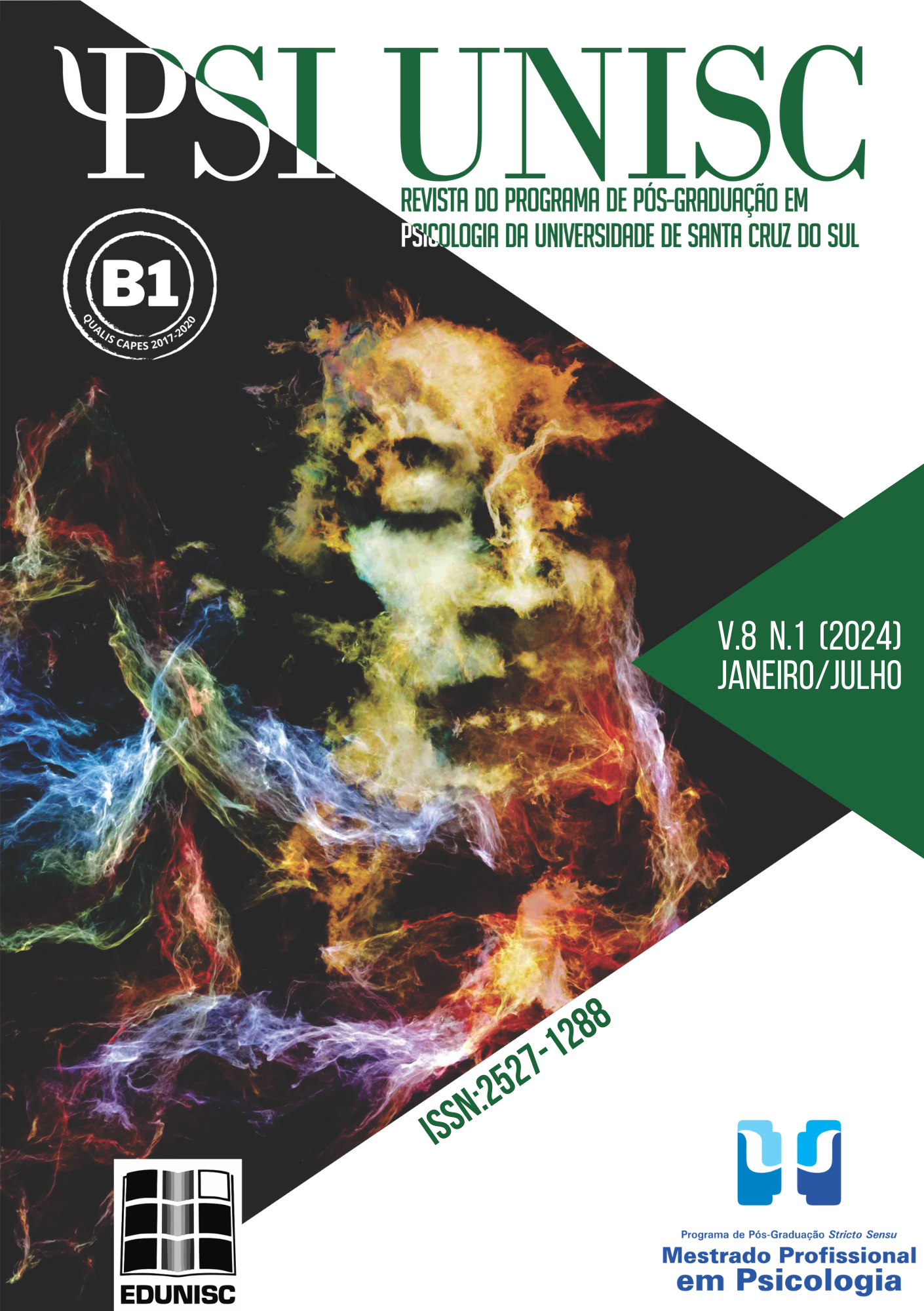Inducción de estereotipos y desaprobación em la memoria de preescolares y escolares
DOI:
https://doi.org/10.17058/psiunisc.v8i1.18492Palabras clave:
Memoria, Sugestionabilidad infantil, Falsos recuerdos, Inducción de estereotiposResumen
El presente estudio investigó el impacto de la inducción de estereotipos y la influencia de desaprobación en la memoria de niños. Participaron cuarenta preescolares (23 niñas, entre 4 y 6 años (M = 62.7 meses, DT = 8.03) y 36 escolares (17 niñas), entre 7 y 8 años (M = 95.4 meses, DT = 6.21) que recibieron una visita de un “científico” que realizó una demostración científica. Se realizaron transmisiones de estereotipo y desaprobación a través de videos. Se realizaron entrevistas para evaluar la memoria de los niños acerca del evento. Los principales resultados indican que los escolares recordaron información más precisa que los preescolares. Además, existe una relación positiva entre el recuerdo preciso de la memoria y la producción de recuerdos relacionados con el estereotipo, que es moderada por la edad de los participantes. La principal contribución es la investigación empírica del impacto que el grupo de edad juega un papel en la precisión de los informes de memoria, y en la relación entre la memoria precisa y los falsos recuerdos.
Descargas
Citas
Amodio, D. (2014). The neuroscience of prejudice and stereotyping. Nature Reviews Neuroscience, 15(10), 670–682. https://doi.org/10.1038/nrn3800
Blasbalg, U., Hershkowitz, I., Lamb, M. E., Karni-Visel, Y., & Ahern, E. C. (2019). Is interviewer support associated with the reduced reluctance and enhanced informativeness of alleged child abuse victims?. Law and human behavior, 43(2), 156-165. https://doi.org/10.1037/lhb0000303
Bodenhausen, G. (2005). The Role of Stereotypes in Decision-Making Processes. Medical Decision Making, 25(1), 112-118. https://doi.org/10.1177/0272989x04273800
Brainerd, C. J., Reyna, V. F., & Holliday, R. E. (2018). Developmental reversals in false memory: Development is complementary, not compensatory. Developmental psychology, 54(9), 1773-1784. https://doi.org/10.1037/dev0000554
Calado, B., Otgaar, H., & Muris, P. (2018). Are children better witnesses than adolescents? Developmental trends in different false memory paradigms. Journal of Child Custody, 15(4), 330-348. https://doi.org/10.1080/15379418.2019.1568948
Ceci, S., & Bruck, M. (1993). Suggestibility of the child witness: A historical review and synthesis. Psychological Bulletin, 113(3), 403-439. https://doi.org/10.1037/0033-2909.113.3.403
Ceci, S., & Bruck, M. (1995). Jeopardy in the courtroom: A scientific analysis of children’s testimony. American Psychological Association. https://doi.org/10.1037/10180-000
Dickinson, J. J., & Poole, D. A. (2000). Efficient coding of eyewitness narratives: a comparison of syntactic unit and word count procedures. Behavior Research Methods, Instruments, & Computers, 32(4), 537-545. https://doi.org/10.3758/bf03200826
Gagnon, K., & Cyr, M. (2017). Sexual abuse and preschoolers: Forensic details in regard of question types. Child Abuse & Neglect, 67, 109-118. https://doi.org/10.1016/j.chiabu.2017.02.022
Goodman, G. S., Jones, O., & McLeod, C. (2017). Is there consensus about children’s memory and suggestibility?. Journal of Interpersonal Violence, 32(6), 926-939. https://doi.org/10.1177/0886260516657358
Johnson, P. O., & Neyman, J. (1936). Tests of certain linear hypotheses and their applications to some educational problems. Statistical Research Memoirs, 1, 57-93.
Klemfuss, J. Z., & Olaguez, A. P. (2020). Individual differences in children’s suggestibility: An updated review. Journal of child sexual abuse, 29(2), 158-182. https://doi.org/10.1080/10538712.2018.1508108
Knippenberg, A. V., Dijksterhuis, A., & Vermeulen, D. (1999). Judgement and memory of a criminal act: the effects of stereotypes and cognitive load. European Journal of Social Psychology, 29(2-3), 191-201. https://doi.org/10.1002/(sici)1099-0992(199903/05)29:2/3%3C191::aid-ejsp923%3E3.0.co;2-o
Lamb, M. E., Brown, D. A., Hershkowitz, I., Orbach, Y., & Esplin, P. W. (2018). Tell me what happened: Questioning children about abuse. John Wiley & Sons. https://doi.org/10.1002/9781118881248
Leichtman, M. D., & Ceci, S. J. (1995). The effect of stereotypes and suggestions on preschoolers’ reports. Development Psychology, 31(4), 568-578. https://doi.org/10.1037/0012-1649.31.4.568
Matute, H., Blanco, F., & Díaz-Lago, M. (2019). Learning mechanisms underlying accurate and biased contingency judgments. Journal of Experimental Psychology: Animal Learning and Cognition, 45(4), 373-389. https://doi.org/10.1037/xan0000222
Mueller, D. H., Compo, N. S., Molina, J., Byron, A., & Pimentel, P. S. (2015). Productive and counterproductive interviewing techniques: Do law enforcement investigators know the difference? Psychology, Public Policy, and Law, 21(3), 295-308. https://doi.org/10.1037/law0000047
Paz‐Alonso, P. M., & Goodman, G. S. (2016). Developmental differences across middle childhood in memory and suggestibility for negative and positive events. Behavioral Sciences & the Law, 34(1), 30-54. https://doi.org/10.1002/bsl.2239
Piaget, J. (1965). The moral judgment of the child. Free Press.
Poole, D. A., & Lamb, M. E. (1998). Investigative interviews of children: A guide for helping professionals. American Psychological Association. https://doi.org/10.1037/10301-000
Reyna, V. F., & Brainerd, C. J. (1995). Fuzzy-trace theory: An interim synthesis. Learning and Individual Differences, 7(1), 1-75. https://doi.org/10.1016/1041-6080(95)90031-4
Rottman, J., Young, L., & Kelemen, D. (2017). The impact of testimony on children’s moralization of novel actions. Emotion, 17(5), 811-827. https://doi.org/10.1037/emo0000276
Schechory, M., Nachson, I., & Glicksohn, J. (2010). Effect of stereotypes and suggestions on memory. International Journal of Offender Therapy and Comparative Criminology, 54(1), 113-130. https://doi.org/10.1177/0306624x08322217
Schein, C., & Gray, K. (2018). The theory of dyadic morality: Reinventing moral judgment by redefining harm. Personality and Social Psychology Review, 22(1), 32-70. https://doi.org/10.1177/1088868317698288
Schneider, W., & Bjorklund, D. F. (1998). Memory. In W. Damon, D. Kuhn, & R. S. Siegler (Eds.), Handbook of child psychology: Cognition, perception, and language (pp. 467-522). Wiley.
Schwartz, B. L. (2020). Memory: Foundations and applications. SAGE Publications, Incorporated. https://doi.org/10.4135/9781526421036842523
Stangor, C., & McMillan, D. (1992). Memory for Expectancy-Congruent and Expectancy-Incongruent Information: A Review of the Social and Social Developmental Literatures. Psychological Bulletin, 111(1), 42-61. https://doi.org/10.1037/0033-2909.111.1.42
Stein, L. M., & Pergher, G. K. (2001). Criando falsas memórias em adultos por meio de palavras associadas. Psicologia: reflexão e crítica, 14(2), 353-366. https://doi.org/10.1590/s0102-79722001000200010
Zollo, L. (2020). The consumers’ emotional dog learns to persuade its rational tail: Toward a social intuitionist framework of ethical consumption. Journal of Business Ethics, 168(2), 295-313. https://doi.org/10.1007/s10551-019-04420-4
##submission.downloads##
Publicado
Cómo citar
Número
Sección
Licencia
La presentación de originales para esta revista implica la transferencia, por parte de los autores, de los derechos de publicación impresa y digital. Los derechos de autor para los artículos publicados son del autor, con los derechos de la revista sobre la primera publicación. Los autores solo podrán utilizar los mismos resultados en otras publicaciones indicando claramente esta revista como el medio de publicación original. Debido a que somos una revista de acceso abierto, se permite el uso gratuito de los artículos en aplicaciones educativas y científicas siempre que se cite la fuente según la licencia CC-BY de Creative Commons.




